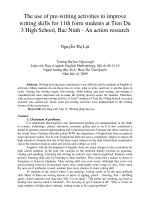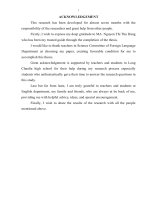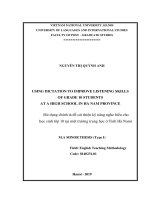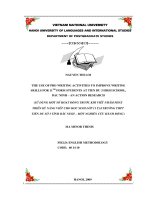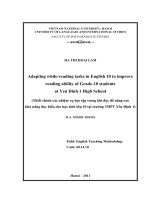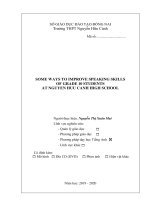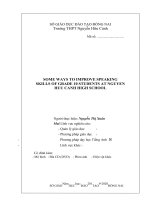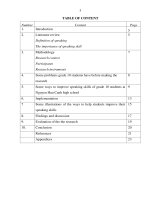(SKKN 2022) using written corrective feedback to improve writing ability of grade 10 students at tong duy tan high school
Bạn đang xem bản rút gọn của tài liệu. Xem và tải ngay bản đầy đủ của tài liệu tại đây (416.48 KB, 37 trang )
TABLE OF CONTENTS
PART I: INTRODUCTION
1. Rationale
English is considered as an international language with more than 1,500
million speakers worldwide. With the current wide usage of Communicative
Language Teaching (CLT) approach in Vietnam, students are taught four main
skills including reading, listening, speaking and writing. Out of them, writing is
the most challenging and least preferable skill for English learners. The
difficulty lies not only in generating and organizing ideas, but also in translating
these ideas into readable text. It means that writing requires English users to
carefully brainstorm to produce words, sentences, and paragraph simultaneously
in order to express their ideas in a comprehensive way.
From my teaching experience, I realized that most of my students at Tong
Duy Tan high school have similar issues with their writing. They often make a
variety of mistakes in the procress of writing all kinds of English
documents.Trying to overcome these challengesis time-consuming, particularly
when students do not have sufficient awareness of the significance of improving
their writing skills. Hence, they are often de-motivated or get discouraged
during writing lessons, which affects their learning results to a certain extend.
Thus, how to improve students' writing as well as to change their attitudes
towards writing activities has greatly attracted my attention.
Some researchers in writing (Leki, 1991; Raimes, 1983) believe that giving
feedback is one of the important ways for teachers to help the writers improve
their writing. Until now, feedback used in pedagogicalcontext is considered as
an essential part of the teaching and learning process to improve knowledge and
skill acquisition. It can not be denied that students want feedback and teachers
feel obliged to provide it. Feedbackcreates interactions between teacher and
students in the second language writing class and it enhances students’ writing
accuracy (Ferris, 1997). Raimes (1983, p.139) also emphasized the importance
of corrective feedback by considering it as "very much a part of the process of
teaching writing". That means corrective feedback is crucial for the success of
writing tasks.
In Vietnam, there have been some researches on teacher’s corrective
feedback but none of the studies investigates the effectiveness of teacher’s
written corrective feedback on grade-ten students’ writing.
For all the reasons mentioned above, the researcher wishes to conduct a
study entitled "Using written corrective feedback to improve writing ability of
grade-10 students at Tong Duy Tan high school”.
2. Aims of the study
This studyaims at investigating the effectiveness of written corrective
feedback on improving students' writing ability.
3. Scope of the study
This study focuses only on the types of written feedback provided by
teachers in language classrooms. Moreover, the participants of this study are 35
grade-10 students at Tong Duy Tan high school that the researcher directly
teaches.
4. Methods of the study
Two methods were utilized to obtain sufficient information for the study,
which are document analysis and action research to improve a situation. After
carrying out an initial investigation, a writing instruction course was designed,
and different types of teacher written corrective feedback were then applied.
The data were collected through analyzing students' writing and survey
questionnaires. Students' writings were collected and analyzed before, during
and after treatment period to measure the students' progress in their writing
2
2
performance. Additionly, students' survey questionnaires were collected and
analyzed at the end of the research to find out their attitudes towards each type
of feedback and its effectiveness.
3
3
PART II: CONTENT
1. Literature review
1.1. Definition of writing ability
Writing ability as a critical theoretical construct that has too often been
interpreted largely by the testing industry as whatever a particular writing test
measures. It means that writing ability has traditionally been defined by test of
writing. Yi(2009) said that the term‘writing ability’ can be defined depending on
the teachers' own experience as a teacher or their ideology on writing.
Also, Yi(2009) said that approaches themselves are classified differently
according to researchers. However, they can be reduced into three major
approaches as following:
1.1.1. Writing ability implied in product/text-oriented approach
Those who think oftextsasautonomous objects define writing ability as the
ability to respond to a given stimulus according to some authority's definition of
the correct response (Nunan, 1999). In other word, it is the ability to adhere to
style-guide prescriptions relating grammar, arrangement and punctuation
without consideration for audience, purpose or context, working on the
assumption that a text can mean the same thing to all people only if it is written
explicitly going after the given prescriptions. Meanwhile, "text-as-discourse"
viewiers consider writing ability as the ability to create coherent and cohesive
discourses following prescribed patterns for developing and organising
discourse.
1.1.2. Writing ability implied in process/cognitive-oriented approach
This approach emphasizes what the composer does throughout writing.
Commonly known as the Process approach, it can be divided into three
subcategories including Expressivist, Cognitivist and Social (Situated)
strands.Learners are encouraged to look for their own authentic voices and
freely express them. Accordingly, the writing activities ultilized by those
4
4
subscribing to this view are likely to be individual essays and journal writing,
which are suitable for self-discovery. Hence, writing ability can be considered
as the ability to freely express oneself. Yi(2009) noted that writing ability in this
approach isdefined as the ability to initiate and evolve ideas and then use certain
revising and editing practices to develop them to maturity in a given context.
1.1.3. Writing ability implied in reader/genre-oriented approach
Yi(2009) said that this Genre-based approach emphasises awareness of the
reader. It regards successful writers as those who are able to make reasonable
assumptions about what readers know and expect, balance between their writing
purpose and readers’ expectations as well as satisfy the readers’ rhetorical needs.
In other words, writing ability is the ability to perform writing tasks for a given
purpose, satisfy a given discourse community concerining the structure and
content of the discourse, and communicate functionally.
1.2. Corrective feedback
1.2.1. Definition of corrective feedback
Definitions for the term "feedback" vary depending on researchers.
Lightbown and Spada (1999, p.172) says that feedback is "an indication to the
learner that his or her use the target languages is incorrect". Teacher feedback
can be considered as an effective means to communicate to students about their
writing so that they can enhance their composition.
Corrective feedback refers to the response that second language students
receive on the errors that they make in their oral or written production. (Sheen,
Y. & Ellis, R. 2011).
When reviewing students' writing, second language teachers give feedback
on various issues. They may address content of the text, idea organization, and
vocabulary choice. Among them, the type of feedback that has attracted
numerous researchers' attentionis feedback on linguistic errors, known as
“corrective feedback” or “error correction”. Yeh and Lo (2009) defines
5
5
corrective feedback as the responses to errors in the text. They also claim that
corrective feedback supplies students with direct or indirect responses about
what is inappropriate. The responses can indicate where the errors are, what
types of errors those belong to; a provision of correct form of the target
language; metalinguistic information about the errors or any combination of
these. Yeh and Lo (2009)'s definition seems to be the most suitable and closely
involves in the scope of this study and is adapted in this study.
1.2.2. Forms of feedback
Basing on forms, feedback is distinguished as two main types which are
oral feedback and written feedback.
1.2.2.1 Oral feedback
Sinclair and Coulthard (1992) claims that oral feedback is “a typical
exchange” in class starting by a teacher, then “followed by a response from the
pupil, followed by feedback, to the pupil's response from the teacher."
Therefore, oral feedback meansa natural part of verbal interaction between
teachers and students, or students and students.
Corrective feedback is used when the teacher gathers the most common
mistakes and corrects them in class. This could be considered to be more groupfocused oral feedback.
1.2.2.2. Written feedback
Written feedback involves feedback given to students' written work. This
type of feedback is usually not provided immediately as teachersneed time to
consider how to give feedback and on what. Therefore, there are different
strategies used when providing students with written feedback. According to
Weigle (2002), the purpose of teachers' feedback lies in providing guidance in
writing.
6
6
a.Peer feedback
Peer feedback is a practice in language education where feedback is given
by one student to another. According to Bartels (2004), peer feedback means
feedback from the fellow students. If students are working on the same
assignment together, peer feedback means exchanging drafts and comments on
each other's drafts. Peer feedback is used in writing classes to provide students
more opportunities to learn from each other.
b. Teacher's feedback
In the light of process writing approach, teachers play an important role in
helping students to revise their writing drafts. Teacher's corrective feedback, to
some extent, is the teacher's correction and can be defined as teachers'
indication to learners' errors, which takes the forms of implicit or explicit
correction. Written corrective feedback refers to teacher written feedback on a
student's essay with an aim of improving grammatical accuracy (including
spelling, capitalization, and punctuation) as well as idiomatic usage (such as
word order and word choice). The primary of this thesis is meant to be an
investigation into how the different teacher written corrective feedback
strategies improve students' writing performance. Some researchers indicate that
students favor corrective feedback from teachers because they believe that they
will benefit greatly from it (Leki, 1990).
c. Teachers' written corrective feedback strategies
There are different classifications for corrective feedback strategies
proposed by different researches. Ellis (2009) presents a typology which
consists of six main strategies to provide corrective feedback (see Table 1).
Table 1: Ellis' typology offeedback types (2009, p.98)
Types of corrective feedback (CF)
1. Direct CF
Description
The teacher provides students with
2. Indirect CF
correct form.
The teacher indicates that an error
7
7
exists but does not provide the
a. Indicating and locating the error
correction
This takes the form of underlining
and the uses of cursors to show
b. Indication only
omissions in the students’ text.
This takes the forms of an indication
in the margin that an error or errors
3. Metalinguitic CF
have taken place in a line of text.
The teacher provides some kinds of
metalinguistic clue as to nature of
a. Use of error code
error
Teacher writes code in the margin
(e.g.: ww = wrong word, pre =
b. Brief grammatical description
prepositions)
Teacher numbers errors in text and
writes a grammatical description for
each numbered error at the bottom of
the text.
Ellis, Loewen and Erlam (2006) categorize responses from teachers to
students' error into three forms or strategies:
(1) teacher feedback that indicates that an error has been made
(2) teacher feedback that provides the correct form of the target language
(3) teacher feedback that provides the metalinguistic information about the
nature of the error.
This current research adapts this categorization together with Ellis'
typology of written corrective feedback in that the focus of this research was
how and whether students' writing performance could be improved through
three main types of written corrective feedback strategies, namely direct,
indirect, metalinguistic corrective feedback.
8
8
As for direct corrective feedback, the teacher gives the corrected form of
the mistake to the students. Direct feedback may be done in various ways such
as by striking out an incorrect or unnecessary word, phrase, or morpheme,
inserting a missing or expected word, phrase or morpheme; and by providing
the correct linguistic form above, in the margin or near the erroneous form
(Ellis, 2008).
Meanwhile, indirect written corrective feedback refers to situations when
the teacher indicates that an error has been made but does not provide a
correction, thereby leaving the student to diagnose and correct it. This can be
done by underlying or circling errors, recording in the margin the number of
errors in a given line, confirmation checks, and request for clarification
(Bitchener, 2008). The last strategy, metalinguistic feedback, could take one of
two forms. Use of error coding or a brief grammatical description. In the former
type, the teacher writes some codes in the margin to suggest what problem
learners have. Of course, the learners will have a list of codes to avoid
confusion. However, in the second type of metalinguistic feedback, the teacher
numbers the errors and briefly provides a brief explanation for the error at the
end of the text.
2. Research setting
2.1. Tong Duy Tan high school
Founded in 1995, Tong Duy Tan high school is located in the mountainous
area of Vinh Loc district, Thanh Hoa city with nearly 50 teachers including 4
English teachers and over 18 classes.
English is among the most important subjects at school. It is one of the
three compulsory subjects of the required examinations the students have to
pass in order to be qualified for the General Education Diploma. The students
have four periods learning English every week. The material is the text book
issued by Ministry of Education and Training. The responsibility of teaching the
9
9
language is on the hand of the teachers of English at the school. The grade 10
students at Tong Duy Tan high school are sixteen years old and have been
learning English for about six years; their English knowledge is generally not
very good, particularly writing skill.
2.2. Participants
This study includes 35 students with relatively equal quantity of boys and
girls coming from class 10B at Tong Duy Tan high school. All of them are
sixteen years old and live around the school.
The students basically are beginners of English despite finishing the
English program for the secondary system. Apart from instructing knowledge in
textbook, the teacher usually has to review the very basic knowledge that they
have learnt at secondary school.
Moreover, there are numerous factors that make teaching and learning
English challenging. Firstly, most of them come from low-income households
and they usually have to help their families to get some more earnings. Beside
that, students have no extra materials except for their textbooks. Therefore,
though most of them have already learnt English for at least four years at lower
secondary school, their knowledge of English is still poor and limited. The other
problem is that they learn English just to pass regular tests or examinations,
while they cannot use English in reality.
The textbooks which are required to teach English for grade-ten students in
high schools are English Basic 10. They were developed based on the old
national curriculum with 16 units, covering four skills.
3. The experiment
3.1. Procedure
Adapting steps in Kemmis' and Mc Taggart's action research cycle (1988,
cited in Burns, 2010. p.9), the action was developed in four steps as follows:
Step 1: Problem identification
10
10
During over-10-year teaching time, the researcher found that the students
seemed to be very weak at writing skills in comparison to English grammar and
vocabulary. More specifically, almost all of the them were not interested in
learning writing, and they often made writing mistakes although they performed
relatively well in reading skills as well as English grammar and vocabulary. To
figure out students' writing problems, the researcher had the students complete a
survey questionnaire (Appendix A) to investigate their attitudes towards English
writing lesson, problems with writing lesson and the possible reasons for these
problems. It turned out that half of the students enjoy writing lesson fairly well
but another half does not like writing at all. A large number of students (28 out
of them) admitted that they found writing the most challenging skill. 25 out of
35 students even said that they did not often get regular, detailed feedback from
teachers, except for some good students, so they hardly know exactly what their
weak points in writing were. Even when feedback was delivered, teachers had
little time to check and process the students' revision so students often remade
mistakes, making error fossilization inevitable. A large number of students
admitted not rewriting their paper so even when they were given feedback on
specific errors, they still repeat the same kinds of error in the next writing. After
the results were obtained, the study was conducted to improve the situation.
Step 2:Planning the action
In order to help students improve their writing ability, the researcher
usedvarious types of written corrective feedback during the pilot teaching. It is
believed that apart from teacher's writing instructions, in many cases, teacher's
correction and comments could help to address the problems of students' writing
accuracy and their attitudes towards writing. It means that teacher's good
feedback strategies may stimulate students to do revision and motivate them to
maintain their interest in writing.
11
11
Due to the time limitation and the writing exercises mainly focus on
specific grammatical features, this study was limited to the investigation of the
impact of 3 written error correction strategies on students' writing performance.
After giving a clear written model, the students were asked to do a sentencebuilding exercise (about 10 sentences) related to the main topics of specific
units in their English book. The time allowance for doing the exercise was about
25 minutes at the class. During this time, they were encouraged to do it on their
own and not to consult any books or their friends. They received feedback on
their work, mainly on their language usage, and then they were asked to rewrite
the exercises based on the teacher feedback and resubmitted a revised draft. The
research was divided into three stages with a different type of feedback applied
for each stage. All the students' papers were collected and analyzed. The error
classification was adapted from five error categories used by Ferris & Roberts
(2001) and based on errors which occurred most frequently in the participants'
writings. The four targeted error types are: verb tense and form, subject- verb
agreement, article and preposition.
The following is the planned timetable (see Table 2) the researcher
followed during 4 months of the action implementation.
Table 2: Timetable of the action implementation
Stage 1 Week
Writing exercise
Types of CF applied
1
Sentence-building exercise 1 & Metalinguistic
Stage 2
12
12
2
Revised draft 1
Sentence-building exercise 2 & Metalinguistic
3
Revised draft 2
Sentence-building exercise 3 & Metalinguistic
5
6
Revised draft 3
Delayed test 1
Sentence-building exercise 1 & Direct
7
Revised draft 1
Sentence-building exercise 2 & Direct
Stage 3
8
Revised draft 2
Sentence-building exercise 3 & Direct
10
11
Revised draft 3
Delayed test 2
Sentence-building exercise 1 & Indirect
12
Revised draft 1
Sentence-building exercise 2 & Indirect
13
Revised draft 2
Sentence-building exercise 3 & Indirect
15
Revised draft 3
Delayed test 3
Step 3: Implementing the action
Stage 1: Metalinguistic corrective feedback applied
Due to the big size of the class and my students' low level of English, I
only used the first form of metalinguistic corrective feedback, which is the
using of error codes. Students were provided a list of error codes (Appendix B)
and all the codes were explained. The list containing abbreviation and symbols
and a gloss of their meanings was adapted from International English Language
Testing System code list.
- After collecting students' written work for the first time, the teacher
labeled different kinds of errors placed over the location of the error in the text
or in the margin, then counted errors.
- Students then got the writings back.
- Next, they rewrote the tasks with correction and resubmitted their writing
exercises.
- The teacher got the papers back, read and counted the errors still
committed.
- The teacher returned the papers to the students.
- After one week, students were asked to write new sentence building
exercises following the same procedure.
13
13
- Two weeks later, delayed test 1 was conducted to see the long-term effect
of metalinguistic corrective feedback.
Stage 2: Direct corrective feedback applied
With this strategy, the teacher provided the students with the correct form
above or near to the erroneous form.
- After having corrected the students' sentence-building exercise 1 for the
first time, the teacher counted errors
- Then, the teacher handed back written work, the students had chance to
look at the papers carefully and rewrote the tasks and resubmitted the papers.
- The teacher got the papers back, kept reading and correcting the second
time, then counted the errors committed and returned the papers to the students.
- One week later, students were required to write new sentence-building
exercises following the same procedure.
- Two weeks later, delayed test 2 was conducted to see the long-term effect
of direct feedback.
Stage 3: Indirect corrective feedback applied
- After the students' written papers were collected for the first time, errors
in students' writing were simply underlined or circle without any correction or
explanation of the errors. The teacher then counted errors.
- Then, students got them back and rewrote the tasks with their own
correction, and handed in the papers.
- The teacher got the papers back, read the second time, counted the errors
committed.
- The teacher then returned the written work to the students.
- One week later, students were required to write new sentence-building
exercises following the same procedure.
- Two weeks later, delayed test 3 was conducted to see the long-term effect
of indirect feedback.
14
14
At the end of the semester, the students were asked to complete a survey
questionnaire (Appendix C) to express their attitudes and opinion on the
effectiveness of written corrective feedback on improving students' writing
performance as well as their preference for certain type of corrective feedback
and suggestions for more effective use of teacher corrective feedback. The
questionnaire was written in English and in Vietnamese so that students could
understand better.
Step 4: Reflecting the action
The data collected during the action implementing period and the students'
survey questionnaires, interviews were analyzed. The results of the analysis
were consulted to find out the effects of different types of written corrective
feedback on students' writing performance. The data analysis results were also
used to answer the research questions.
The reflection was done at the end of the cycle. The results of the analysis
after implementing the action were evaluated to see whether the action was
effective or not. Because of the limited time, the researcher would not continue
the action in the next cycle.
3.2. Results
3.2.1. Effects of three common types of feedback on students' writing
performance
3.2.1.1 Effects of three common types of feedback on students' revised
writing papers
With a view to assessing the effects of teacher different feedback strategies
on student revision actions and behaviors, all students' initial writing papers and
the revised drafts were analyzed and compared. The collected data in Figure 4.1
clearly indicated the revision effects.
15
15
Figure 3.2.1: Effects of three common types of feedback on students' revised writing exercises
From these above data, it seemed that students would be most successful in
incorporating direct corrective feedback into their revision, since it mostly
involved transcribing or copying of the teacher's suggestion into the next draft.
In fact, the students were able to make correct change in response to direct
feedback in the vast majority (93.2%) of the case. This finding suggested that
direct feedback was more helpful to students in revision because it reduced the
type of confusion that could occur if learners failed to understand or remember
what the feedback was saying. Direct feedback also provided learners with
sufficient information to resolve more complex errors (for example, errors in
verb tenses and form). This is consistent with Lightbown's (2006) conclusion
that every repetition and instance of language use prompted by written
corrective feedback can enhance the memory effect. Moreover, direct feedback
provided learners with more immediate feedback on hypotheses that they may
have made. However, even when students received direct corrective feedback,
there were still a certain number of errors (6.8%) in the second draft. One
16
16
possible explanation lies in the fact that the second draft was not always a
duplicate of the first draft with the errors corrected. Students were sometimes
required to extend their first draft and revise some of the contents based on the
content feedback provided by the teacher. When students wrote more, there
were more chances for them to make errors. The findings are similar to those of
Ferris and Roberts (2001) that indirect correction does not seem to have
immediate advantage over direct correction.
Interestingly, the other, less explicit forms of feedback also led to accurate
revisions most of the time. Metalinguistic feedback, in which errors were
underlined and marked with error codes, led to correct edits in 86.8% of the
instances. More interestingly, the research also found that indirect feedback
could be traced to 86.1% of the accurate changes.
Concerning different types of errors, almost all of grammatical errors such
as verb tense and form, subject-verb agreement, article and preposition were
successfully edited. However, some of the correction was not successful.
Grammatical errors were easier to correct since students could choose the right
morphological form for different situations, such as the past tense and subjectverb agreement, as long as they knew the rules. For metalinguistic feedback and
indirect feedback, the second draft still contained a certain number of errors.
While trying to make sense of the data (see Figure 3.2.1), I found that
students were able to make effective revision in response to teacher's corrective
feedback. However, it is suggested that when considering the effects of teacher
corrective feedback, more attention should be paid to whether they could
integrate what they learnt from teacher feedback and revision action in the new
assignments. According to Ferris (1999, 2004), the efficacy of error feedback
needs to be evaluated by measuring accuracy on new texts. Therefore, in this
study the reseacher measured the changed linguistic accuracy through a series of
assigned writing exercises.
17
17
3.2.1.2. The effects of three common types of feedback on students' new
writing exercises
This part presents the results of investigating the extent to which different
types of corrective feedback on five targeted linguistic errors helped learners
improve the accuracy of their writing when doing new writing exercises. The
result was reflected by the data collected in the three following figures.
a. Description of the students' performance in Stage 1 - Metalinguistic
corrective feedback applied
Figure 3.2.2: Taxonomy of errors and their frequency in Stage 1
It can be seen from Figure 3.2.2 that the total number of errors varied from
222 errors for writing exercise 1 to 210 errors for exercise 2 and 198 errors for
exercise 3. The biggest number of errors was verb tense and form with 75 errors
(33.7%) for exercise 1, 71 errors (33.8%) for exercise 2, and 69 errors (34.8%)
for writing paper 3. The number of article errors ranked second with 64 errors
(28.8%) for exercise 1, 62 errors (29.5%) for exercise 2, and 49 errors (24.7%)
for exercise 3. The number of preposition errors remained in third position and
18
18
makes up 25.2% (56 errors) for exercise 1, 25.7 % (54 errors) for exercise 2,
and 26.2% (52 errors) for exercise 3. Errors of subject-verb agreement ranked in
fourth place.
It is clearly shown from Figure 3.2.2 that the total number of errors for the
delayed test is 181 compared to 222 errors for exercise 1, 210 errors for exercise
2 and 198 errors for exercise 3. Among the four categories of errors, the ones of
verb tense and form showed a slight decrease. The number of subject verb
agreement errors and article dropped from 28 errors (14.1%) and 49 errors
(24.7%) for exercise 3 to 19 errors (10.4%) and 38 errors (20.9) for the delayed
test respectively. For the other types of errors, there was not any decrease in the
number of errors. There was a little variation in the number of errors between
exercise 3 and the delayed test.
b. Description of the students' performance in Stage 2 - Direct corrective
feedback applied.
Figure 3.2.3: Taxonomy of errors and their frequency in Stage 2
The data collected in stage 2 show that the total number of errors made by
35 students fluctuated from 214 errors for exercise 1 to 205 errors for exercise
19
19
2, and 199 errors for exercise 3. Of all these four types of errors presented in
Figure 3.2.3, errors verb tense and form and preposition were the most
noticeable. The biggest number of errors went with verb tense and form with 79
errors (36.9%) for exercise 1, 76 errors (37%) for exercise 2, and 79 errors
(39.6%) for exercise 3. Errors of preposition ranked in second position with 59
errors (27.5%) for exercise 1, 63 errors (30.7%) for exercise 2, and 60 (30.1%)
for exercise 3. The third position of errors belonged to article with 53 errors
(24.7%) for exercise 1, 44 errors (21.4%) for exercise 2, and 40 (20.1 %) for
exercise 3. The fourth place in the table were errors of subject-verb agreement
with 23 errors (10.7%) for exercise 1, 22 errors (10.7%) for exercise 2, and 20
errors (10%) for exercise 3. The delayed test data was analyzed to determine the
types and frequency of the errors made one week after treatment.
It is clearly seen from Figure 3.2.3 that the total number of errors for the
delayed test was 199 compared to 214 errors for exercise 1, 205 errors for
exercise 2 and the same number of errors for exercise 3. Among the main four
categories of errors, the ones preposition showed a slight decrease, the number
of errors went down from 60 errors (30.1%) for exercise 3 to 55 errors (27.6%)
for the delayed test. Regarding verb tense and form and subject verb agreement,
the number of errors mostly stayed the same. In contrast, the number of article
errors increased slightly from 40 errors (20.1%) for exercise 3 to 45 errors
(22.6%) for the delayed test.
c. Description of the students' performance Stage 3 - Indirect corrective
feedback applied.
20
20
Figure 3.2.4: Taxonomy of errors and their frequency in Stage 3
The data collected in stage 3 show that the total number of errors went
down considerably from 203 errors for exercise 1 to 186 errors for exercise 2
and 155 errors for exercise 3. Most types of errors showed a decrease in
number. The biggest number of errors went with verb tense and form with 79
errors (38.9%) for exercise 1, 71 errors (38.1%) for exercise 2, and 60 errors
(38.7%) for exercise 3. Besides, the number of preposition errors ranked in
second position with 57 errors (28%) for exercise 1, 53 errors (28.4%) for
exercise 2, and 45 errors (29%) for exercise 3. The number of article errors was
in third position and made up 24.1% (49 errors) for exercise 1, 24.7% (46
errors) for exercise 2, and 25.8% (40 errors) for exercise 3. Subject verb
agreement errors reduced gradually over time.
It is also demonstrated in Figure 3.2.4 that the total number of errors for
the delayed test was 123 compared to 203 errors for exercise 1, 186 errors for
exercise 2 and 155 errors for exercise 3. The number of grammatical errors
showed a remarkable decrease. The number of preposition errors fell from 45
21
21
errors (29%) for exercise 3 to 33 errors (26.8%) for the delayed test. Regarding
verb tense and form, the number of errors went down from 60 errors (38.7%)
for exercise 3 to 50 errors (40.6%) for the delayed test. In terms of article, the
number of errors was 40 errors (25.8%) for exercise 3 and 31 (25.2%) for the
delayed test.
3.2.1.3 Discussion
The students' writing performance demonstration in exercise 1, exercise 2,
exercise 3 and the delayed test clearly showed that, in stage 1, when
metalinguistic feedback was applied there was a very slight decrease in the
number of errors in exercise 2 and exercise 3 compared to exercise 1.
After one week, the number of errors in the delayed test was on the same
decline, partly due to the delayed test was carried out rather shortly after
exercise 3 so students may still remember. Looking back at the students' essays
in this stage, it is found that when some students received coded corrective
feedback on some linguistic errors they still could not correct on their own, thus
errors were unavoidable. In this stage, when metalinguistic corrective feedback
was applied, the number of article errors constantly reduced. This result was
similar to the finding of Sheen (2007). He found that metalinguistic corrective
feedback was effective in increasing accuracy in the students' use of articles in
subsequent writing completed immediately after the corrective feedback
treatment. However, there was little change in other kinds of errors or there
were even a greater number of preposition errors compared to exercise 3. When
asked for reasons, some students said that though there was a code from the
teacher, they did not find the right word to replace it because there were so
many choices. Therefore, they still made these types of errors in the next
exercise. The research also find that the overall accuracy of the participants
varied significantly across the four writing times in the same stage. In other
words, there was not a linear and upward pattern of improvement from one time
22
22
to another. This is not surprising as earlier research has shown that second
language learner, on the process of learning new linguistic forms, may perform
them with accuracy on one occasion but fail to do so on other similar occasions.
It is demonstrated in Figure 3.2.3 when direct corrective feedback was
applied that rewriting following a teacher's direct corrections resulted in almost
the same number of errors on a subsequent assignment and the delayed test even
though students made much fewer errors on revision of the same assignment. It
meant that students' short-term ability to edit certain types of errors did not
always translate to long-term improvement. As can be seen in Figure 3.2.3,
although the students made fewer errors in exercise 2 and exercise 3 compared
to exercise 1, the change was not significant. In the delayed test at the end of
stage 2, there were the same number of errors compared to exercise 3. This is
partly due to the fact that the time for direct feedback to be applied is not long
enough for students to incorporate what they have learnt from that period into
their language input. Furthermore, in this stage, the teachers provided the
students with the correct form in every error, thus it is not necessary for students
to give much thought to revision and this direct intervention did not appear to
have any lasting effect over time. Therefore, after a week without any feedback,
the students may forget what they learnt from teacher direct feedback. This
finding is in line with Ellis's finding (2009) that direct feedback requires
minimal processing on the part of the learners and thus, it may not contribute to
long-term learning. Regarding different types of errors, in stage 2 when direct
feedback was used, the number of errors in verb tense and form and article are
not on the decline after each exercise. These kinds of errors even show a slight
increase in the number in the delayed test in comparison with exercise 2 and 3.
There are fewer numbers of errors of subject verb agreement and preposition.
In contrast, rewriting based on a teacher's underlining lead to fewer errors
on a subsequent assignment and in the delayed test (see Figure 3.2.4). This
23
23
shows some advantages of underlining as a strategy for corrective feedback.
When students received underlining only in the last assignment, they had to
work out correction themselves, and this process likely improved their selfediting ability. Thus, they were more conscious of the linguistic errors when
writing a new essay. In other words, indirect feedback that students received
may have helped them more over time because it consistently called these errors
to their attention, triggering the "guided learning and problem-solving"
processes as recommended by Lalande (1982, p.140). Considering different
types of errors in this stage, students make fewer errors in exercise 2 and
exercise 3 and the delayed test in almost all of categories of errors. The students
make a lot of improvement in the grammatical usage. The reduction of errors in
verb tense and form, preposition is significant. This indicates that when
receiving less explicit feedback, students pay some attention to language usage
when they do a different exercise. Although this awareness cannot be
completely attributed to the effect of indirect correction they received on the
previous exercises, the process of finding out the correct form by students
themselves in the revision of the first exercise seems to help students internalize
the rules related to the grammatical errors. The result of this comparison
collaborates with Bitchener et al's (2005) finding that indirect corrective
feedback resulted in greater accuracy in terms of the simple past tense and the
definite article. In brief, after three stages of correction, the total number of
errors declines. However, using different feedback strategies can change the
number of individual error type flexibly. It is found from Figure 3.2.2, 3.2.3,
3.2.4, that after each correction, the changing of the number of each error type is
not the same for all. The data collected in all three stages has shown that
positive feedback strategy can help students to reduce errors in writing and
among these three strategies, indirect corrective feedback with suitable
procedures make great sense, though the effectiveness of teacher corrective used
24
24
in this stage may be influenced by the two preceding stages. It is suggested that
indirect feedback is more effective than direct and metalinguistic feedback in
the long run and it is also argued that indirect feedback requires students to
engage in guided learning and problem solving and, as a result, promotes the
type of reflection, noticing and attention that is more likely to foster long-term
acquisition (Ferris and Roberts, 2001).
3.2.2. Students' opinions towards teacher corrective feedback
The results from the survey questionnaires indicate that 100% (35
students) agreed that corrective feedback is very important to the improvement
of students' writing ability. About 97.1% of the students (34 of out of 35
students) admitted that teacher corrective feedback had positive effect on their
writing performance and about the same number of students wished to receive
more feedback in the future. The students' positive attitude towards teacher
corrective feedback explained the steady reduction in the number of errors in
the students' essay before and after the feedback was provided. In contrast, only
one student said that there was no improvement in their writing ability after
corrective feedback strategies were applied. Looking back at this student's
writing papers, it was interesting to see that, his performance in the writing
paper was not very good. Moreover, he was the one who did not usually
perform well in English lessons.
4. Significance of the study
The study proves that written corrective feedback is crucial to the teaching
and learning of writing. Written corrective feedback offers a number of
advantages. Apart from rasing student’s writing quality, it gives both the readers
and the writers more opportunities for collaboration, consideration and
reflection than oral negotiation and debate. It also gives the teacher a better
chance of closely following the progress of individuals and groups, both in
terms of the feedback offered and revisions made.
25
25
